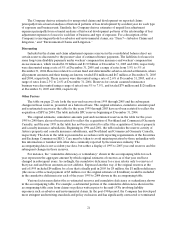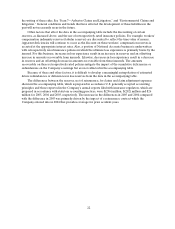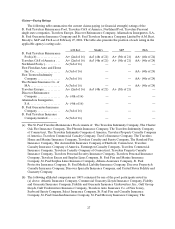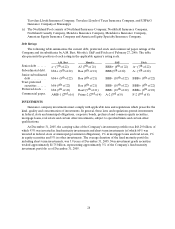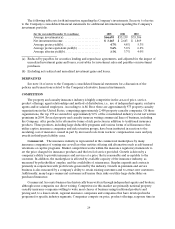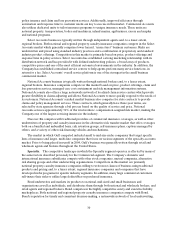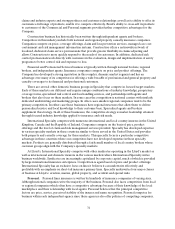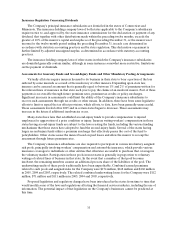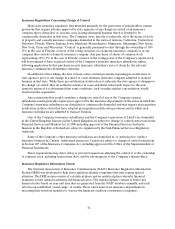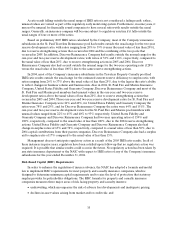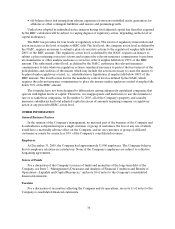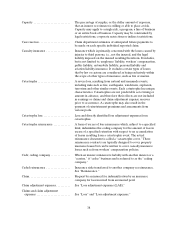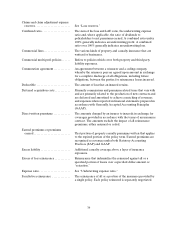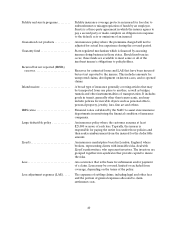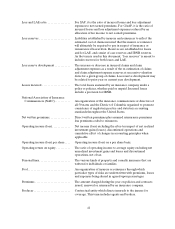Travelers 2005 Annual Report Download - page 43
Download and view the complete annual report
Please find page 43 of the 2005 Travelers annual report below. You can navigate through the pages in the report by either clicking on the pages listed below, or by using the keyword search tool below to find specific information within the annual report.31
claims and industry experts and strong producer and customer relationships as well as its ability to offer its
customers a full range of products, enable it to compete effectively. Bond’s ability to cross-sell its products
to customers of the Commercial and Personal segments provides further competitive advantages for the
Company.
Construction business has historically been written through independent agents and brokers.
Competitors in this industry include both national and regional property casualty insurance companies.
Companies compete on price, coverage offerings, claim and loss prevention services, managed care cost
containment and risk management information systems. Constructionoffers a nationwide network of
localized, dedicated claim service professionals that provide greater flexibility in claims adjusting and
allows Construction to more quickly respond to the needs of its customers. In addition, dedicated risk
control professionals work directly with customers in the evaluation, design and implementation of safety
programs to better control risk and exposure to loss.
Financial and Professional Services business is typically written through national brokers, regional
brokers, and independent agents. Insurance companies compete on price and product offerings. The
Company has developed a strong reputation in this complex, dynamic market segment and has an
advantage over many of its competitors in offering a wide breadth of professional and general property and
casualty coverages to its financial and professional customers.
There are several other domestic business groups in Specialty that compete in focused target markets.
Each of these markets are different and require unique combinations of industry knowledge, proprietary
coverage forms, specialized risk control and loss handling services, and partnerships with agents and
brokers that also focus on these markets. In some cases the competition is national carriers with similarly
dedicated underwriting and marketing groups. In other cases smaller regional companies tend to be the
primary competition.In either case these businesses have regional structures that allow them to deliver
personalized service and local knowledge to their customer base. Specialized agents and brokers
supplement this strategy. Inall of these businesses, the competitive strategy is market leadership attained
through focused industry knowledge applied to insurance and risk needs.
International Specialtycompetes with numerous international and local country insurers in the United
Kingdom, Canada and the Republic of Ireland. Companies compete on the basis of price, product
offerings and the level of claim and risk management services provided. Specialty has developed expertise
in various specialty markets in these countries similar to those served in the United States and provides
both property and casualty coverage for these markets. This specialty focus is a particular competitive
advantage in these countries where our competitors have not developed expertise in these specialty
markets. Products are generally distributed through a fairly small number of local country brokers whose
customer groups align withthe Company’s specialty markets.
At Lloyd’s, International Specialty competes with other syndicates operating in the Lloyd’s market as
well as international and domestic insurers in the various markets where International Specialty writes
business worldwide. Syndicates are increasingly capitalized by corporate capital, much of which is provided
by large international insurance enterprises. Competition is again based on price and product offerings.
International Specialtyhas an exclusive focus on lines it believes it can underwrite effectively and
profitably with an emphasis on short-tail insurance primary lines. Specialty underwrites four major classes
of business at Lloyd’s: aviation, marine, global property, and accident and special risks.
Personal.Personal lines insurance is written by hundreds of insurance companies of varying sizes.
Although national companies write the majority of the business, Personal also faces competition from local
or regional companies which often have a competitive advantage because of their knowledge of the local
marketplace and their relationship with local agents. Personal believes that the principal competitive
factors are price, service, perceived stability of the insurer and name recognition. Personal competes for
business within each independent agency since these agencies also offer policies of competing companies.


